Why you can trust TechRadar
We spend hours testing every product or service we review, so you can be sure you’re buying the best. Find out more about how we test.
Bosgame GVP7600: 30-second review
If you think your PC is struggling, especially with anything too graphically intensive, like high-resolution image editing or video, then it might be time to upgrade. However, if your machine features a Thunderbolt 3, 4 or USB4 port and is able to support an eGPU, then the Bosgame GVP7600 eGPU might be a cheaper and far more effective option.
Essentially, it’s an eGPU, but what Bosgame have done is to ensure that it’s far more plug-and-play than your average eGPU with a few extra ports for connectivity and the ability to install an internal M.2 SSD so that you can also boost your machine’s internal storage.
Getting set up is relatively easy; simply plug the USB4 cable from the eGPU into your machine and then the HDMI/DisplayPort into your monitor. Then it should just be a simple case of switching everything on, and the machine should boot as normal, but now with the power of a dedicated eGPU rather than your machine’s internal integrated GPU.
Through the test, the ease of setup varied greatly depending on what desktop PC, laptop or mini PC it was linked to, and in almost all cases, a quick check of firmware and updates needed to be carried out before the eGPU could be fully recognised, but this is standard eGPU practice.
This review centred on the Intel NUC i9 Ghost Canyon machine that utilises integrated graphics, and whilst it still features a relatively powerful CPU when it comes to graphics power, it’s somewhat lacking. In the past, I’ve relied on a discrete graphics card internally or an eGPU to give it the graphics power it deserves, so it’s a good test of the Bosgame GVP7600.
In the same way as my usual Razor Core X with relatively old ASUS GeForce RTX3060 Ti enables the smooth running of 3D applications, games, and Premiere Pro, Lightroom and Photoshop, this far simpler all-in-one solution far outstriped that card performance.
On the Ghost Canyon, the card was plugged in, and the GVP7600 had been with several mini PCs, but initially, there seemed to be an issue, and it wasn’t recognised, so I unplugged the HDMI cable from the GVP7600 to the monitor and plugged it directly into the PC, then the USB4 was unplugged and plugged back into the computer at which point the machine recognised the eGPU. The HDMI was then plugged into the eGPU rather than the PC so that the communication from the eGPU to the computer was solely through the USB4 cable, and everything worked fine. It was then a case of installing the AMD RX7600M drivers, and this was a download and install directly from the AMD website rather than any integrated software package from Bosgame itself. Whilst this was a little convoluted, it installed absolutely fine, giving full access to the Adrenalin package.
Once the initial setup was done, future reboots were seamless, and when you shut down your machine and restarted it, the GPU was recognised along with the internal M.2 SSD that I installed and any peripherals that were plugged into the docking ports. On more modern mini PCs and laptops, the process was less convoluted and generally, after a few seconds of plugging in the eGPU and booting up, everything worked absolutely fine.
As an eGPU, there’s a little bit more depth to it than most. With the Intel NUC i9 Ghost Canyon, there was a huge jump in GPU performance, and games which were previously unplayable due to either being very stuttery or just not running at all worked perfectly, with both Hogwarts Legacy and Indiana Jones and the Great Circle running smoothly, whereas previous they were both a bit jittery.
Switching over to Premiere Pro, Adobe Photoshop and Lightroom, again, there was a definite boost in graphics processing, really refreshing the usability of this now older computer.
For the most part, there is a general boost in performance across the board, but a couple of negative points about the eGPU: firstly, it is still a mobile chip, so at close to $500/£500 it is a significant investment, and there’s no upgrade path, if you do in the future want to re-upgrade that GPU to something else you really have to start fresh. Also, the fan noise is relatively high, and even in the lower power mode, it’s still audible. As default, the TPU is set to 100W, as highlighted by the orange light on the top of the box, but it is possible to switch this to 60W, which should allow for quieter use. But to be honest, that’s a small price to pay for the boost in performance that your machine will have.
Overall, the negatives are far outweighed by the positives that this small eGPU will bring to your machine, giving a graphics boost across the board and being most notably beneficial if you’re working in the creative sector or want to play some of the latest games on your older machine.
Bosgame GVP7600: Price and availability
- How much does it cost? £418 / $559
- When is it out? Now
- Where can you get it? Widely available
The Bosgame GVP7600 is widely available and can be purchased directly form the Bosgame website or from many major online retailers such as Amazon.
Bosgame GVP7600: Design
Specifications
GPU: AMD RX 7600M XT (8GB GDDR6, RDNA3, 32 CUs)
TDP: 100 W base, 120 W Turbo
RAM: 8GB GDDR6
Storage: M.2 PCIe 3.0 slot (up to 4TB)
Front Ports: SD card reader
Rear Ports: 2x HDMI 2.1, 2x DP 2.0, 1x USB-A 3.2, RJ45, Thunderbolt 3, OCuLink, DC power
Connectivity: Thunderbolt 3/4, USB-4, OCuLink, Ethernet
Audio: via GPU
Size and Weight: approx 1.8–1.9 kg, aluminium chassis
Accessories: Thunderbolt/DP cables, 230 W power brick, basic manual
The Bosgame GVP7600 eGPU has an instantly striking look with its white body and high-tech, almost cyberpunk design. It definitely has a touch of the gamer, rather than what you’d expect for the sleek design of the creative market; it’s obvious the main focus is the gaming market.
Inside is the AMD RX 7600M XT GPU and this is a mobile graphics chip that is often found in many laptops and mini PCs, but its power is significant, which also makes it a superb option for a portable eGPU that can be taken with you alongside a mini PC or laptop when you need a graphics power boost. Its small size and scale make it far more portable than larger eGPUs from the likes of Razer Core X.
While the exterior of the eGPU is plastic, it’s all very good quality and features a metal interior, which helps with dissipating the heat and keeping the system running smoothly.
When it comes to its size and dimensions, at its widest, tallest and deepest, it measures 110 x 237 x 44mm (not including the cable or the power supply required), and it weighs in at 961 grams. So, whilst it is small and portable, it’s not ultra-lightweight. However, compare this against the Razer Core X eGPU, which is commonly used, it is far smaller and lighter.
Take a look around the body, and there’s plenty of venting all around, which is needed in order to keep the small GPU inside nice and cool. On the back of the machine, where all the display ports are, you’ll find 2x DP, 2x HDMI, OCuLink, USB4, which plugs into your computer, DC input, an RJ45 LAN and a USB-A port. On the side, there is also an SD card reader.
So, while there is some docking potential, in reality, aside from the monitors, you really only have that single USB-A port to plug in other peripherals. But then again, you can also plug in your RJ45 LAN.
Essentially, if you are using this as a docking station, then it’s ready to dock your laptop or mini PC into up to four monitors and possibly a mass storage device that you can plug into that USB-A port.
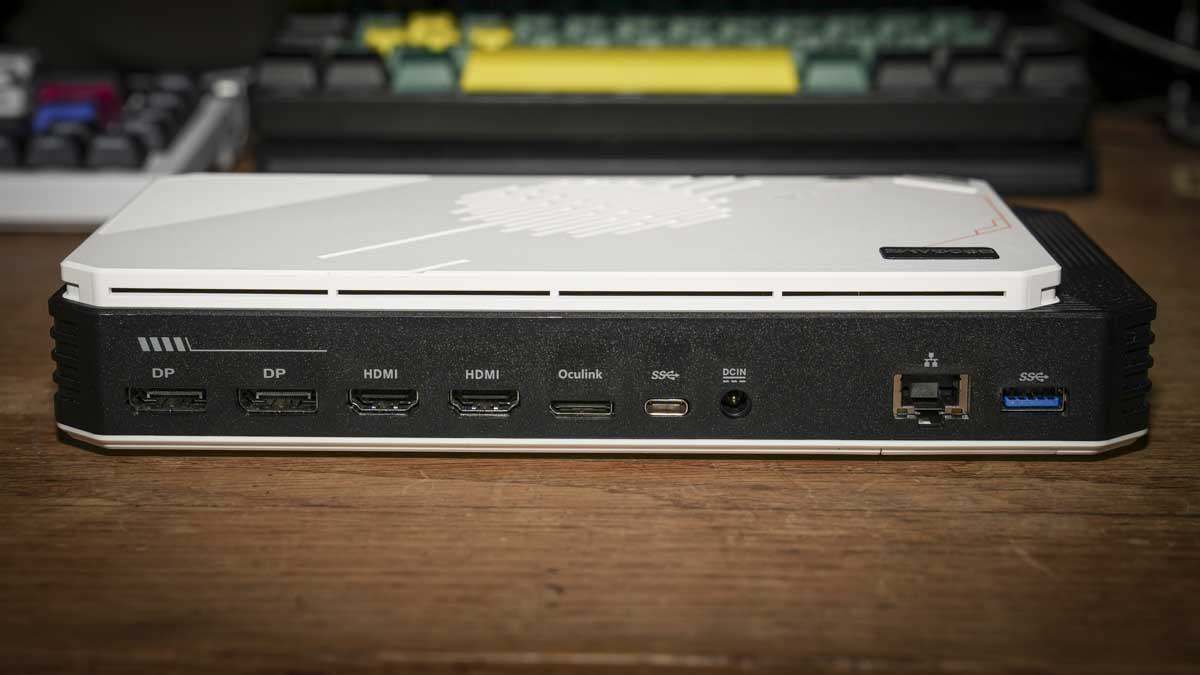
One of the features that I really like is the fact that it has an M.2 NVMe 2280 slot on the base, and this is ready to take any M.2 SSD that you might wish to install up to 4TB. The installation is easy, with just a simple cover over the slot, and then you screw it into place as per usual. Once installed, you can format it, and it’ll work like any other external storage device, appearing in your drive options and ready for you to use. If you are using this for gaming, you can store all your game data; likewise, if you’re working in the creative sector, you can store your creative projects on this drive, and again, it’s a really nice working solution.
An interesting point of the design is the TGP toggle button on top, and essentially, this switches the power from 100W to 60W, which should keep the fans at relatively low noise and potentially the performance.
One point I will say about the build and design is that while the unit itself is actually very neat, it does require a power supply, and this is relatively large, measuring 177 x 80 x 30 mm and weighing 734g plus the weight of the cabling. Also, while it’s almost plug and play, once you’ve installed everything, the initial setup can be a little bit start-stop, with you needing to install additional drivers and firmware in order for your machine to recognise the eGPU, but to be honest, it’s pretty standard across most eGPUs.
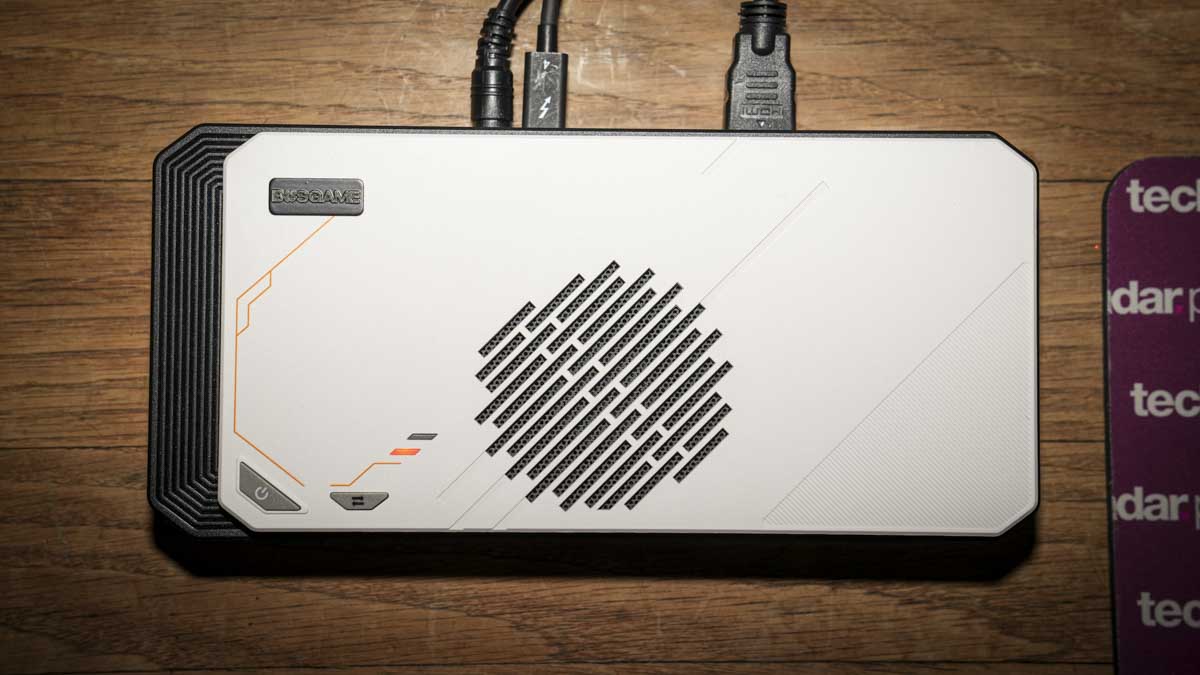
Bosgame GVP7600: Features
Compared with other eGPUs, there’s a little bit more to the Bosgame GVP7600 eGPU. First and foremost, it has the RX7600M XT, which is a mobile GPU, as I’ve already highlighted and supports ray tracing. So, for games especially, that is going to boost the overall performance and frame rate of your gameplay, but for those working in 3D and video, it also gives a few more options.
One of the things that I really like is that you have two power options, either 60 or 100 W, and the difference between these when it comes to the noise of the fans is significant. When you’re running 100W, there should be a step up in the performance as well, although, in the tests, I saw very little actual difference, so day to day, you can conserve power by taking it down to 60W, then, when you’re gaming or working in the video where you no that extra power might be needed, you can turn it up to 100W to gain that extra performance.
The AMD Radeon RX7600M XT offers a 6nm production process and graphics card architecture RDNA 3.0, 32 compute units and 8GB of memory capacity, with a gaming frequency of 2300 MHz and memory speed of up to 18Gbps, which for most mid-range creative and gaming at 1080 or 1440 resolution use should be more than adequate at present.
Obviously, with the display being the main point of this eGPU on PC systems, you can support up to four displays using the HDMI and DP ports, with it featuring 2x DP (4K 120Hz-8K 60Hz) and 2x HDMI ports offering (4K 120Hz-8K 60Hz)
Alongside the standard display ports, you have a USB4, which is used to plug directly into your computer (so it can’t be used for anything else); then there’s a USB 3.2 type-A, and this can be used for attaching peripherals or mass storage devices, then there’s an SD card reader, OCuLink and the RJ45 LAN port so you can plug it directly into your network.
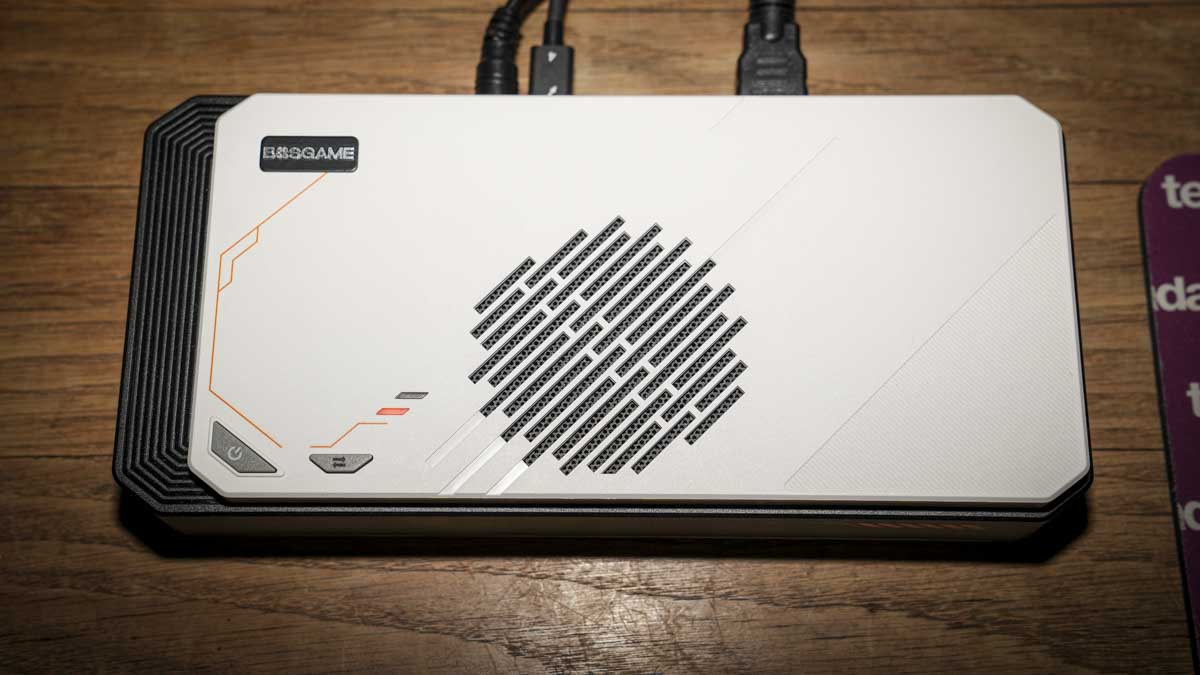
Bosgame GVP7600: Performance
The installation of the Bosgame GVP7600 does take a little bit of fiddling around than expected, and as I explained earlier on, on the Intel NUC i9 Ghost Canyon, I needed to first ensure that the machine was booting normally; then I plugged in the USB4 cable from the eGPU to the machine until it pinged to say that it recognised an eGPU was plugged in and that it was now usable. At this point, I could then unplug the HDMI cable, the one from the PC, to the monitor and plugged it back into the GVP7600, and everything worked fine.
I then had to go along to the AMD website, download the drivers for the RX7600M XT, install these, reboot so that Adrenalin could take over, and then everything worked absolutely fine from there on. When I shut down the Intel NUC i9 Ghost Canyon with the GPU plugged in, the next time I booted up the machine, it booted absolutely fine. Likewise, when I unplugged the eGPU and booted normally without the eGPU being plugged in, it booted into Windows without any issues using the internal graphics.
When it came to the performance, there was a huge uplift in the graphics potential, with Adobe Photoshop and Premiere Pro just taking a leap in speed and performance. When more graphics-intensive manipulations or effects were being used, there was an increase in the speed and ease of the workflow. Likewise, when it came to rendering out video in Premiere Pro, the machine was noticeably faster.
However, the biggest difference came when playing games, and two games that used to really struggle on the machine without a dedicated GPU, Hogwarts Legacy and Indiana Jones and the Great Circle, refused to run. Now, with the RX7600M XT powered graphics, both not only ran but ran exceptionally smoothly with great gameplay and graphical quality, even though still limited to HD resolution.
While I was unable to test OCuLink, it is nice to know that the OCuLink port is there, so for newer machines, this is definitely going to be advantageous, giving very small mini PCs a huge graphics boost.
One of the other highlights of the performance was when I tested it on multiple machines, and it highlighted that the performance of the graphics card is, rather obviously, related to the technology of the port that it’s plugged into. So when using a Thunderbolt 3 machine, the performance was stepped down from that of a Thunderbolt 4 machine. For the duration of this test, I utilised the Intel NUC i9 Ghost Canyon, which features Thunderbolt 3, and even then, the performance and the graphics upgrade were impressive.
One interesting result from the Benchmarks was the SSD test and SD tests. While the SD card reader performance was impressive, with the UHS-II Lexar card tested, putting in impressive results, the PCIe Gen3 M.2 SSD fast recorded slower results than I had expected. However, looking into this, the reason could be due to the slower Thunderbolt 3 port bandwidth; however, testing the same drive on a USB4-equipped machine again produced similar results.
|
Test |
SD Card |
SSD |
|
CrystalDiskMark Read: |
258.78 |
786.21 |
|
CrystalDiskMark Write: |
189.77 |
702.87 |
|
AJA System Test Lite Read: |
228 |
735 |
|
AJA System Test Lite Write: |
234 |
676 |
|
AS SSD Benchmark Read: |
255.16 |
755.30 |
|
AS SSD Benchmark Write: |
251.21 |
672.79 |
|
ATTO Disk Benchmark Read: |
247.94 |
779.39 |
|
ATTO Disk Benchmark Write: |
256.81 |
695.02 |
|
Mini PC |
Header Cell – Column 1 |
Results base |
100W |
60W |
|---|---|---|---|---|
|
3DMark |
WildLife |
3211 |
35860 |
35462 |
| Row 1 – Cell 0 |
Fire Strike Overall |
1343 |
19134 |
19398 |
| Row 2 – Cell 0 |
Fire Strike Graphics |
1454 |
22331 |
22195 |
| Row 3 – Cell 0 |
Fire Strike Physics |
20300 |
21223 |
21340 |
| Row 4 – Cell 0 |
Fire Strike Combined |
452 |
8615 |
9319 |
| Row 5 – Cell 0 |
Time Spy Overall |
536 |
9339 |
9079 |
| Row 6 – Cell 0 |
Time Spy Graphics |
461 |
9339 |
9079 |
| Row 7 – Cell 0 |
Time Spy CPU |
7348 |
9121 |
9318 |
|
CineBench23 |
Single |
1154 |
1206 |
1137 |
| Row 9 – Cell 0 |
Multi |
7580 |
7775 |
7751 |
|
GeekBench |
Single |
1592 |
1706 |
1706 |
| Row 11 – Cell 0 |
Multi |
6744 |
7329 |
7327 |
| Row 12 – Cell 0 |
Compute |
5915 |
74189 |
71898 |
When it came to some of the small issues about the eGPU, the first was that installation wasn’t always as straightforward as I felt it should be, and much of this came down to a slightly limited set of instructions for the setup. While it’s not too difficult to work around and figure out how to make it work, something a little clearer in the instruction manual would have been nice.
Likewise, there’s no software installation that comes with the hardware, but the manual simply directs you to go to the AMD official website and download the RX7600M XT driver. It would be nice if this had been bundled in some simple and easy-to-use download from their website.
When it comes to their website, whilst the graphics card is listed, there’s no direct link to any decent support, so if you do have questions about the user installation, then that’s a little bit tricky to find.
The main thing that I would have liked to see is some software that goes with the eGPU, with an option to eject the GPU along with any storage, including the internal M.2. With a Mini PC, this isn’t an issue, as you will more than likely shut down the machine, but with a laptop, you’re likely to just unplug without ejecting and down the line this may cause issues as it’s not best practice.
When it comes to the other features, mainly the RJ45 and the USB-A and SD card slot, these are really nice additions to have. While it’s not a full-blown docking station, at the same time, it doesn’t sell itself as being so, but to have these extra features again just adds to its usability.
For me, one of the biggest added extras has to be the inclusion of the M.2 SSD slot, and popping in a 2TB SSD into the base of the machine really did give a lot more use to the eGPU. So not only was it boosting the graphics potential of my machine, but it was also boosting the storage available, and that’s something I really like, and it’s nice to know that I can put up to 4TB of SSD into this particular machine.
At the end of the test, the performance of the graphics card was obviously the main focus, and as the results show, there really is hardly any comparison between the internal graphics and the potential of the machine after connecting the GVP7600.
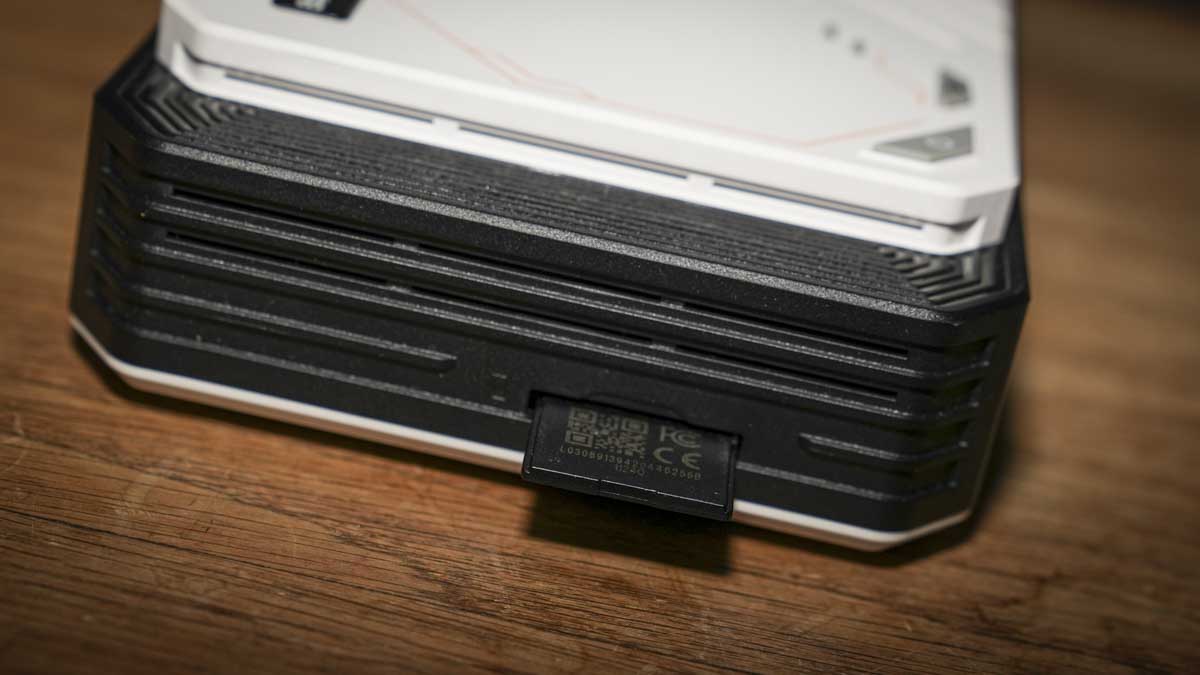
Bosgame GVP7600: Final verdict
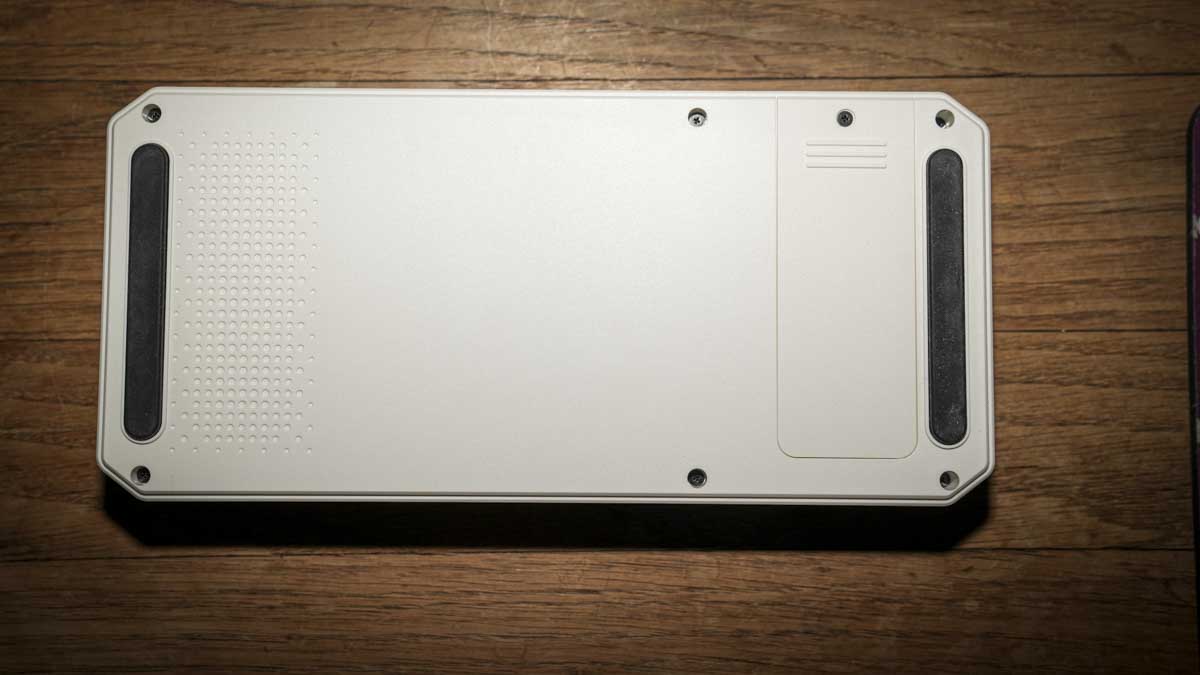
If you’re looking to give your mini PC or laptop a graphical performance boost, the GVP7600 eGPU is a great option. Yes, it does come in at £500/$500, but then that is far less than a mini PC or laptop with this graphics potential built-in, and it also saves you needing to set up and get used to a new machine.
When it comes to performance, there’s no doubt about the increase in graphics potential for both creative applications and games, and the fact that it is relatively easy to set up on most machines is also a major benefit, meaning that if you have little to no technical ability, then you should still be able to use this device.
There are a few downsides, as with some machines, it takes a little bit of fiddling just to get the eGPU recognised, and you need to make sure that your machine is fully up-to-date with firmware and software updates. You also need to do a bit of trawling along the Internet just to find the correct drivers, but when you type “RX7600M XT driver” into Google, the AMD listing is right at the top, so in reality, it’s not too difficult to find.
Ultimately, if you just want a very easy-to-use eGPU with the potential for expanded storage and the ability to plug in an accessory and the network, then this is a great, easy-to-use option.
Should I buy a Bosgame GVP7600?
|
Value |
It is rather expensive, but then it’s less than buying an equivalent mini PC or a laptop with this level of graphics potential |
4 |
|
Design |
It is rather expensive, but then it’s less than buying an equivalent mini PC or a laptop with this level of graphics potential |
4 |
|
Features |
A decent range of features all around, including that internal option for an SSD. It would be nice to have one or two more ports |
4 |
|
Performance |
Outstanding boost to graphics performance for older machines that feature Thunderbolt 3, 4 or USB4 |
4.5 |
|
Overalls |
The performance boost that this eGPU gives can’t be disputed, but it does come at a cost, and there’s no upgrade route in the future |
4 |









